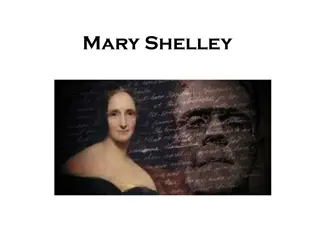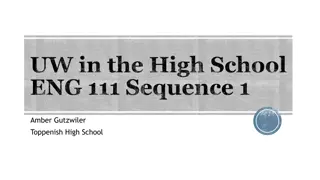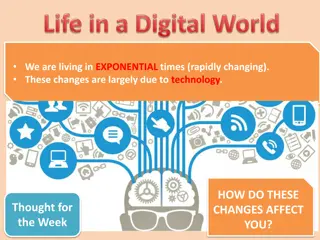Federal LCA Commons: Advancing Environmental Information and Labeling
Federal LCA Commons is a collaborative platform for advancing environmental information and labeling through Environmental Product Declarations (EPDs) and the Nutrition Label Analogy. This initiative aims to enhance data reliability, standardization, and market uptake, facilitating major industrial
2 views • 18 slides
Exploring Economics in Everyday Life with Jack Meaning
Engage students in understanding the impact of economics through activities centered around the book "Can't We Just Print More Money?" by Jack Meaning. From discussing sandwiches as an analogy for economic concepts to exploring career paths and financial literacy, this lesson plan aims to enhance st
0 views • 18 slides
Understanding the Marriage Relationship in Ephesians 5:25-27
Delve into the intricate analogy of Christ's love for the Church mirrored in the marriage relationship as outlined in Ephesians 5:25-27. Explore the profound symbolism of mutual love, sacrifice, and sanctification between spouses, echoing the divine unity between Christ and His Church.
2 views • 9 slides
Mary Shelley's Frankenstein: An Intriguing Introduction
Mary Shelley, born in 1797 to writers William Godwin and Mary Wollstonecraft, had a tumultuous life that greatly influenced her masterpiece, Frankenstein. Her novel, framed within a frame story by Robert Walton, explores themes of ambition, creation, and the consequences of playing god. The settings
4 views • 14 slides
The Concept of the Noble Savage in Frankenstein by Mary Shelley
The concept of the noble savage, popularized by Jean-Jacques Rousseau and reflected in Mary Shelley's novel Frankenstein, explores the idea that humans are inherently good in their natural state. Shelley portrays this through the creature, who, despite his primitive nature, displays love and kindnes
0 views • 6 slides
Irony, Paradox, Oxymoron, and Parallelism in Frankenstein
Exploring the concepts of irony, paradox, oxymoron, and parallelism in Mary Shelley's "Frankenstein." The discussion covers different types of irony such as situational, verbal, and dramatic, highlighting instances from the novel. Additionally, the concept of paradox is examined, showcasing statemen
0 views • 16 slides
Mary Shelley and Her Masterpiece: Frankenstein
Mary Shelley, born in 1797, was a talented writer known for her novel "Frankenstein, or The Modern Prometheus," published in 1818. The origin of the story dates back to a ghost story challenge in 1816, inspired by a nightmare. The narrative unfolds through multiple voices, including explorer Robert
1 views • 9 slides
Understanding Mitosis: An Analogy Project Explained
Mitosis is the cell duplication process consisting of five stages - Prophase, Metaphase, Anaphase, and Telophase (PMAT). This analogy project by Avelina and Marissa creatively compares mitosis to a Physical Education class activity, making the complex scientific concept easy to grasp. The stages of
0 views • 5 slides
Understanding Religious Language: Analogy and Interpretation
Exploring the use of analogy and interpretation in religious language, this content delves into the views of St. Thomas Aquinas and Ian Ramsey regarding the challenges of conveying meaning through analogies. Aquinas rejected univocal and equivocal language for discussing God, emphasizing the limitat
0 views • 18 slides
Exploring Analogy and Religious Language in Philosophy
Dive into key terms like disclosure, qualifier, and models in the context of analogy and religious language as discussed by philosophers like Aquinas and Ian Ramsey. Explore concepts of language, analogy, and the application of human understanding to divine attributes.
0 views • 18 slides
Understanding Figurative Language in Frankenstein
Figurative language in Frankenstein plays a crucial role in conveying deeper meanings and creating vivid imagery. Similes and metaphors are used to draw comparisons between characters and objects, adding layers of complexity to the narrative. Through examples like comparing Elizabeth's soul to a shr
2 views • 15 slides
Mary Shelley's Background and the Inspiration Behind Frankenstein
Mary Shelley, born in England in 1797, was raised by her father after her mother's death. She was influenced by her father's student, Percy, a Romantic poet with a tumultuous personal life. The complex relationships and events in Mary Shelley's life, including elopements, suicides, and new love inte
0 views • 6 slides
Halloween Celebrations in Germany
Halloween has made its way to Germany from America, with people dressing up in spooky costumes, attending pumpkin festivals, and participating in traditional activities like trick-or-treating. The Darmstadt Fortress, also known as Frankenstein's Castle, hosts popular Halloween parties, adding a hist
0 views • 7 slides
Exploring Critical Theory Through Literary Criticism and Analogy
Delve into the realm of critical theory through literary criticism, using the analogy of different perspectives on seeing an orange to understand the various facets of analysis like reader response, Marxist/social power, feminist/gender, and psychoanalytic criticism. Discover how critical theory hel
0 views • 9 slides
Themes of Society and Psychology in Frankenstein
Society unfairly associates physical deformity with monstrosity in Mary Shelley's novel, Frankenstein. The abandonment and lack of proper nurture shape the monster's nature, while Victor and his creation struggle with gender identity. Frankenstein's self-centeredness leads to self-destruction, and t
0 views • 14 slides
Summary of Frankenstein: Friendship, Tragedy, and Guilt
Unlike Walton, Victor has friends in Elizabeth and Henry Clerval. As Victor delves into science, particularly alchemy, he discovers the power and potential destructiveness of knowledge. Tragedy strikes with Elizabeth's illness and his mother's death, leading Victor to study science seriously. His ac
0 views • 12 slides
Analysis of Romantic and Gothic Elements in Frankenstein by Mary Shelley
This analysis explores the parallels between Mary Shelley's Frankenstein and Romantic and Gothic literary elements, delving into themes of creation, hubris, nature, and the supernatural. The narrative revolves around Victor Frankenstein's pursuit of creating life, intertwined with Romantic ideals an
1 views • 11 slides
Exploring Contextual Ideas in Frankenstein by Mary Shelley
An analysis of contextual ideas related to the study of Frankenstein by Mary Shelley. Delve into the key connotations, connections with other literary texts, and the enduring resonance of a novel written almost 200 years ago. Understand the significance of the contexts in which literary texts are wr
0 views • 57 slides
Exploring Atmosphere and Themes in Frankenstein Through Letters
The novel "Frankenstein" by Mary Shelley unfolds through a series of letters that set the scene for a haunting narrative. The story begins with explorer Robert Walton writing to his sister about his ambitious voyage to the North Pole. Through letters, themes of loneliness, despair, and the danger of
0 views • 13 slides
Exploring AI Ethics Through Frankenstein Analogy
Delve into the ethical considerations surrounding artificial intelligence by examining parallels between AI creation and Mary Shelley's Frankenstein. This faculty workshop or classroom activity encourages insightful discussions on the implications of AI development and the responsibility that comes
0 views • 12 slides
Exploring Mary Shelley's Life and Frankenstein: An Intriguing Tale
Mary Shelley, the daughter of Mary Wollstonecraft and William Godwin, displayed literary talent from a young age. She met Percy Shelley at 19, leading to the creation of her famed novel, "Frankenstein". The story revolves around Victor Frankenstein, his creation, and the tragic consequences that fol
0 views • 10 slides
Analysis of the Monster Frankenstein by Estela and Marina García Pintos
The monster in Frankenstein, created by Victor Frankenstein, is a giant, hideously ugly creature with delicate emotions seeking companionship. Initially feared and rejected, he longs for connection and is betrayed by his creator. The monster's journey unfolds through loneliness, longing, revenge, an
1 views • 11 slides
Understanding Gothic Fiction Conventions
Explore the origins and key features of Gothic fiction, including dark settings, supernatural elements, and eerie atmospheres. Analyze gothic story openings and extract examples from works like Frankenstein to understand gothic features and emotional impact.
0 views • 25 slides
Exploring the Origins and Evolution of Gothic Literature
Gothic literature traces its roots back to Horace Walpole's novel "The Castle of Otranto," characterized by medieval settings, supernatural elements, and themes of terror and fear. Writers like Mary Shelley, Bram Stoker, and Edgar Allan Poe further popularized the genre with works such as "Frankenst
0 views • 6 slides
Variety of Verbal Analogy Questions and Practice Sets
Explore a variety of verbal analogy questions and practice sets focusing on different types of relationships between words. From number series to verbal classification, essential parts, analogies, artificial language, and more, these exercises aim to enhance your verbal reasoning skills and logic. L
0 views • 20 slides
Mary Shelley, William Godwin, and Mary Wollstonecraft: Pioneers of Modern Thought
Mary Shelley, daughter of Mary Wollstonecraft and William Godwin, was influenced by her parents' radical philosophies. Wollstonecraft advocated for women's rights and education, while Godwin believed in individualism and anarchism. Their ideas shaped Mary Shelley's literary works, including "Franken
0 views • 19 slides
Analysis of "Frankenstein" by Mary Shelley as a Modern World Literature Piece
Frankenstein" by Mary Shelley, published in 1818, tells the story of Victor Frankenstein and his creation. The narrative unfolds through letters, revealing themes of creation, responsibility, and societal rejection. The novel delves into complex moral questions and explores the consequences of unche
0 views • 13 slides
Analyzing Character Development and Point of View in Literature
The content provides guidance on analyzing the development of characters in literary texts, evaluating authors' choices of point of view, and understanding how these elements influence readers' perceptions. It includes discussions on Victor's view of science in "Frankenstein," guiding questions for
0 views • 8 slides
Nature's Healing Power: Exploring Isolation and Connection in Literature
Delve into the themes of nature, isolation, and egoic thinking in literary works like "Frankenstein" and "A New Earth." Discover how characters find solace in nature amidst feelings of alienation and how shifting focus from self to the natural world can transform attitudes. Engage in creative activi
0 views • 8 slides
Reasoning Ability Test - Analogy, Classification, Coding-Decoding Examples
Explore analogy, classification, and coding-decoding examples from the SBI Junior Associates Preliminary Test 2018 section on Reasoning Ability. Test your logical thinking skills with questions and answers related to similarities, grouping objects, and secret message patterns.
0 views • 10 slides
Gothic Literature Analysis and Exploration in ENG 111 Sequence
Dive into a captivating journey through Gothic Literature with in-depth analyses on works by H.P. Lovecraft, exploration of Vampire Literature, and literary examinations of classics like Dracula and Frankenstein. Uncover rhetorical strategies, thematic elements, and enduring impacts in this ENG 111
0 views • 5 slides
Literary Devices in Frankenstein: Analysing Simile, Metaphor, Symbol, Motif, and Allusion
Explore the intricate use of simile, metaphor, symbol, motif, and allusion in Frankenstein through excerpts from Letter 1-4 and Chapters 1-12. Dive into the vivid comparisons, symbolic representations, and layered meanings embedded in Mary Shelley's classic novel.
0 views • 11 slides
Exploring Classic Literature Themes and Characters
Delve into the analysis and personal reflections of iconic literary works such as "Pride and Prejudice," "Frankenstein," "Wuthering Heights," "Dr. Jekyll and Mr. Hyde," and "1984." Uncover themes of love, morality, duality, and societal control depicted in these timeless novels.
0 views • 24 slides
Frankenstein's Tragic Story Unveiled Through Shocking Events
Embark on a journey through the tumultuous life of Frankenstein as we reveal the shocking events that shaped his existence: a mix of love, loss, and the pursuit of forbidden knowledge, leading to a creation that would haunt him forever.
0 views • 77 slides
The Impact of Technology: Reflections from Frankenstein
Living in rapidly changing exponential times, the influence of technology is profound. Through an extract from Mary Shelley's "Frankenstein," we delve into the consequences of scientific advancements. Victor Frankenstein's creation, brought to life through technology, elicits a range of emotions and
0 views • 6 slides
Portrayal of Science's Impact on Social Order in Literature
Explore the depiction of science's influence on social order in literary works like "Frankenstein" and "The Handmaid's Tale," comparing the portrayal of societal impacts, scientific creations, and thematic elements. Analyze the evolving perceptions of readers across different time periods and consid
0 views • 15 slides
Themes of Society and Psychology in Frankenstein
Society unfairly associates physical deformity with monstrosity in Frankenstein, shaping the monster's nature through abandonment and lack of nurture. The struggles of Victor and his creation with gender identity and self-centeredness lead to self-destruction, illustrating themes of tampering in God
0 views • 14 slides
Frankenstein Home Learning Week Summary
In this home learning week focused on Frankenstein, students engage in various activities related to defining and deconstructing phenomena, exploring vocabulary like remorse, and analyzing the character of the Creature. Activities include defining terms, recalling story events, and contemplating the
0 views • 27 slides
Understanding MapReduce: A Real-World Analogy
MapReduce is a programming model used to process and generate large data sets with parallel and distributed algorithms. In this analogy, the process of depositing, categorizing, and counting coins using a machine illustrates how MapReduce works, where mappers categorize coins and reducers count them
0 views • 43 slides
Evolution of Science Fiction Literature
Science fiction genre, blending imaginative fantasy with scientific principles, has evolved significantly over time. Initially emerging in the late 1800s, it gained popularity alongside technological advancements. Theodore Sturgeon highlighted the essence of human stories within the genre. Iconic wo
0 views • 8 slides







































